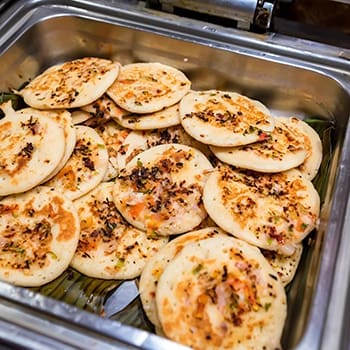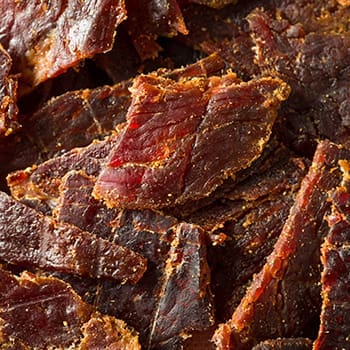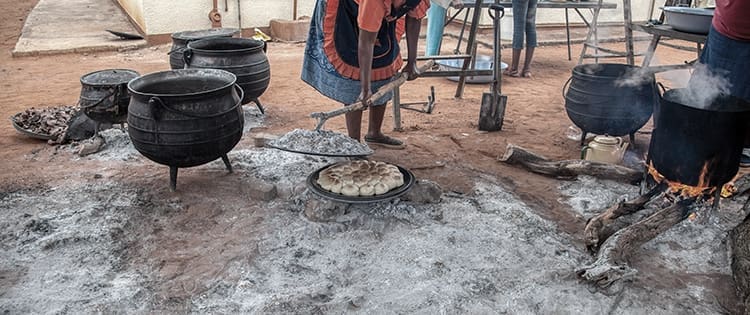Ah, howdy! I’m glad y’all just pulled your wagon on up and asked us for some cookin’ advice.
Okay, I can’t write the whole post like that, but we’re looking at Pioneer recipes. These are primarily the recipes of white colonialists that were making their way through Indigenous lands and did not either know or trust the local population enough to really do much in the way of trading or asking how they were living off the land. Indigenous peoples rarely used these specific recipes, though you will find that white colonialists did start copying them and using similar methods, eventually. Let’s get to it!
Flatcakes
There is an enormous array of flatcakes that were made back in the day of covered wagons and colonizing. Most of them involve a starchy product, an egg or two, salt, and a source of liquid. Depending on the situation and time of year, that could be water, milk, or even beer or liquor. Though, honestly, water was more abundant in these areas back then simply because fewer people lived in these areas than they do now, therefore, there was less demand for water did exist.
Ideal flatcakes are cooked on a hot griddle, usually greased with butter or lard (most often pork lard). If you’ve just made bacon, we strongly recommend cooking in the same griddle or pan as you used for the bacon so long as the bacon did not scorch. Few colonists had large amounts of cooking implements with them and it was common to use one pan for the entire meal. By doing it this way, you will find that it is more authentic. The flavors are deeper. And you’re eating what your ancestors did as they roamed the plains in search of new homes for themselves.
Recipe:
- Somewhat wiggle room on all ingredients.
- EITHER 4 potatoes, peeled and grated OR 2 cups of corn meal (yellow, or you can use white or even stone ground grits if desired)
- 1 cup of flour
- 1-ish cup of milk or water (you’re looking for a moderately thin batter)
- 2 eggs
- hefty pinch of salt
Mix all ingredients and pour by ladleful onto a hot griddle. Cook as you would a pancake. May be eaten savory or sweet as desired.
Simple, classic, and easy to make; these will really stick to your ribs and keep you going all day long. You may also just up the flour or use buckwheat instead. Johnnycakes are a variety of these, though often made with whole wheat flour and a little more egg.
Cured Meats
We may be cheating a little bit with this category since it is simply enormous. Cured meats were eaten everywhere, by everyone, during this period in history and for millions of years before it (after it probably, too!). Curing meat has made it more available to us for a long, long time.
So how do you cure your own meats? Most people simply don’t. They go to the store and grab that package of jerky or bacon right off the shelf without ever considering just how hard it is to make your own. And don’t get us wrong, we think it’s worth the test of time to do it. …But you’re going to work for that beautiful finished product.
We’ll be looking at jerky rather than bacon simply because smoking and curing bacon is a lot longer process than jerky is.
Paprika Jerky Recipe:
- 3 pounds of London broiled beef, sliced very thin
- 1 dehydrator (if you have a smoker, feel free to use it)
- Fresh smoked paprika; if you can get the whole peppers, that’s even better!
Add your beef to your dehydrator. If you have whole peppers, slice them thinly and rest them on the meat for the duration of the dehydration process. This encourages all of the juices and bits to seep into the beef and really gives it that dark, rich flavor that so many jerky lacks. If you can only find pre-ground paprika, we recommend dry marinating overnight in the refrigerator and then wiping off the beef before you place it in the dehydrator the next morning.
Run a full cycle on your dehydrator and enjoy a piece of fresh, lean jerky that will have you ready to take on any cattle rustler that dares cross your path.
Soda Biscuits
No, not hardtack; though hardtack and similar hard, flatbreads were frequently eaten during this period. Soda biscuits are very simple biscuits that can be whipped up in a snap, dropped by the spoonful onto a pan, and cooked alongside everything else for breakfast. Then they keep well through lunch, dinner, and probably until the next breakfast (if you don’t run out of them).
Recipe:
- 3 cups of flour
- Milk (we’ll explain this in a second)
- 1 teaspoon salt
- 1 teaspoon baking soda
Pour your dry ingredients together in a large mixing bowl and mix well. Add milk until you have a dough that is waffle-like in consistency. Simply toss these biscuits in a pan, or in the oven at 425 until the edges darken and the tops are golden brown (around 15-20 minutes). In a buttered pan, you’ll end up with a crispier biscuit. They come out fluffier in the oven. You tell us which way you’ve tried these and what you’ve put on them; our favorite is plain, simple honey or making a quick white gravy from sausage drippings! Yum!
Final Thoughts
What recipes have your family handed down from their colonialist era? What foods do you picture pioneers eating while they were traveling through lightly inhabited Indigenous land on the way to connect the coasts of the nation we live in today? And what do you picture them getting from the land or from the Indigenous people; that answer may surprise you! We invite you to look at some of our Indigenous-inspired articles regarding their recipes and compare them with pioneer ones, here. That will lead you to some interesting discoveries!
Looking for a particular recipe but unsure of the name or ingredient measurements? Leave us a comment down below and if we can help, we will!
You may also like:
Native American Recipes Every Homesteader Must Know
The Only Food That Grows Almost Faster Than You Can Eat It (Video)
Cheap Recipes To Keep You Well Fed In The Next Crisis
Recipes I Made From The Lost Super Foods Book: Canned Hamburger Meat









